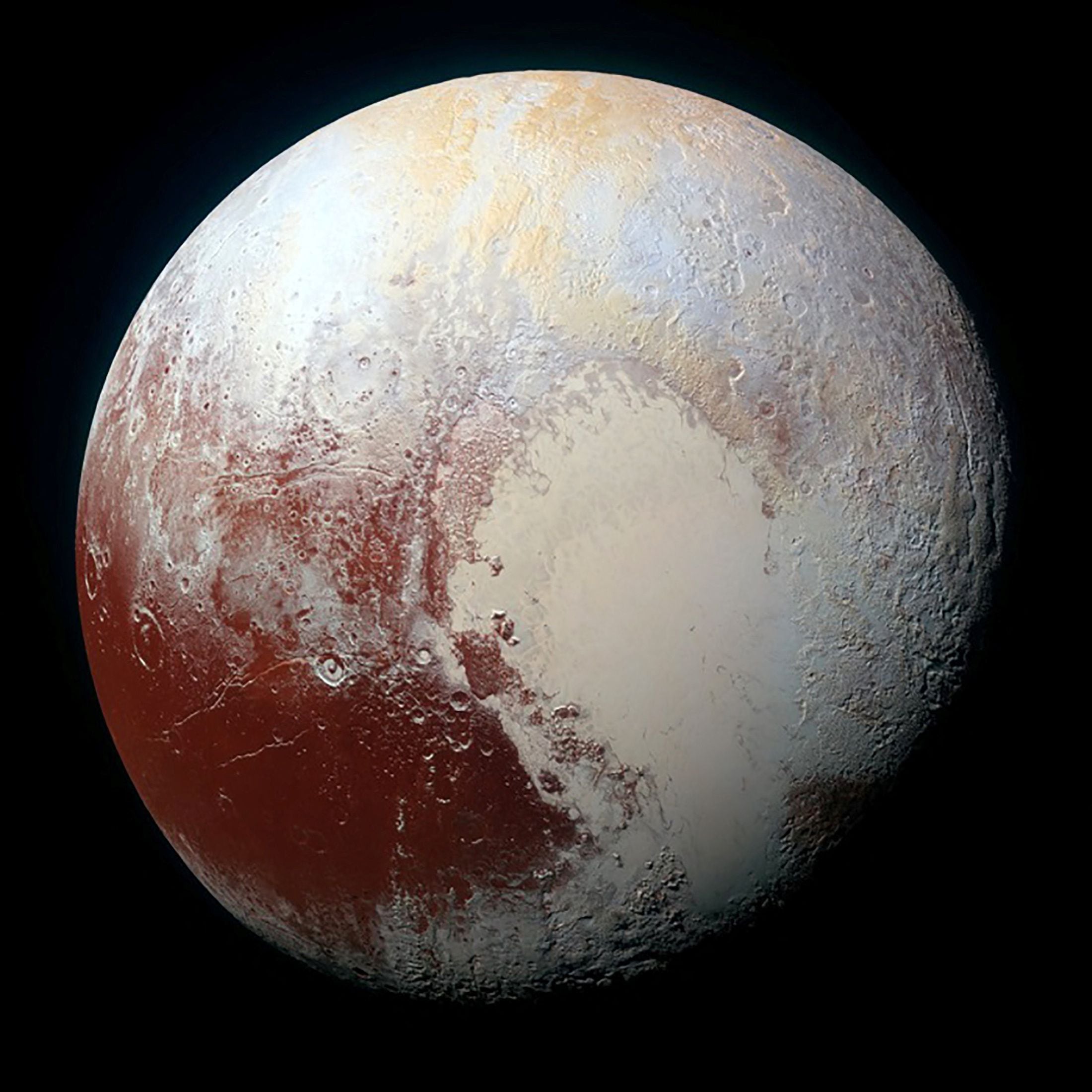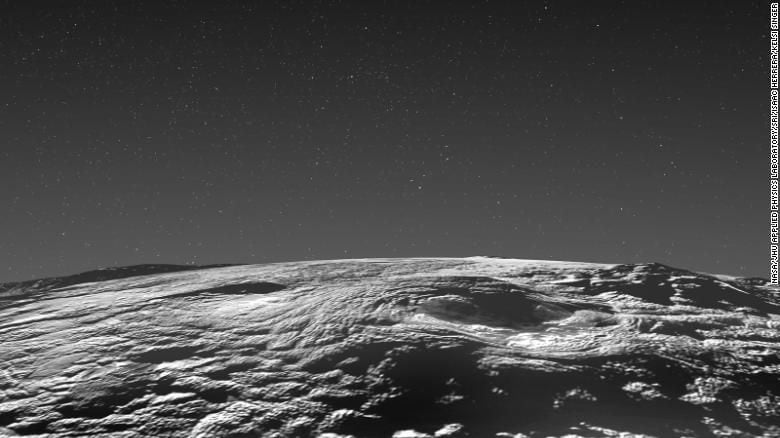
NASA's New Horizons mission continues to amaze scientists. When the probe flew over today's dwarf planet in 2015 it took never-before-seen photographs of the most important distant object in our Solar System.
The data and information provided by the ship are still analyzed by experts who come up with incredible theories about the formations that exist there and that the heat beneath the surface of the dwarf planet could even hint at the potential of life. An area of Pluto that researchers believe formed from the eruption of ice volcanoes is unique in that cold distant world. The mission, which was launched in 2006, took detailed photographs of the surface of Pluto, a dwarf planet and the largest object in the Kuiper belt.
Now, a new scientific article published in the journal Nature Communications examines images of a area containing two major mounds that experts have proposed as ice volcanoes. In the study, the researchers conclude that the surface around these mounds was probably formed by the fairly recent activity of ice volcanoes or cryovolcanoes.
The finding raises the possibility that these volcanoes may still be active and that liquid water, or something like that, recently flows or flows under the surface of Pluto. Recent activity also means that there is likely to be more heat inside Pluto than scientists previously thought. Given other recent research, they say their work could even increase the likelihood of life beneath Pluto's surface.
The researchers analyzed photographs of a region dominated by two large mounds, called Wright Mons and Piccard Mons, which scientists believe are cryovolcanoes. Wright Mons is a mountain 4 to 5 kilometers high and approximately 150 km wide, while Piccard Mons is approximately 7 km high and 250 km wide.
The alleged ice volcanoes also have extremely deep depressions in their peaks: that of Wright Mons is as deep as the height of Mt. Many parts of the area also have an unusual appearance, full of lumps or “mounds”, formed by undulating, rounded mounds. Researchers believe that smaller mounds, formed by ice volcanoes, could have accumulated over time to form these two major mounds.
“There were no other areas on Pluto that looked like this region. The way these features look is very different from that of any volcano in the solar system, whether they are icy examples or rocky volcanoes. They formed like mountains, but there is no caldera on top, and they have big bumps everywhere,” said Kelsi Singer, a planetary scientist at the Southwest Research Institute in Boulder, Colorado and lead author of the study. Although Pluto has a rocky core, scientists have long believed that the planet lacked much inner heat, which is necessary to stimulate volcanism. To create the region that Singer and his team studied, there would have been several eruption sites.

The research team also noted that the area has no impact craters, which can be seen on Pluto's surface, suggesting that ice volcanoes were active relatively recently, and that Pluto's interior has more waste heat than expected. “This means that Pluto has more internal heat than we thought, which means we don't fully understand how planetary bodies work,” Singer said. Based on the lack of craters, the area is likely to be no more than one or two billion years old, and some areas are probably less than 200 million years old.
In a way, cryovolcanoes are analogous to Earth's volcanoes, in that much of Pluto's surface is made of ice and temperatures on Pluto are well below the freezing point of water. That means that liquid water, or something similar that is at least partially fluid or mobile, would be like magma on Earth, coming to the surface after an eruption and freezing, or hardening, into a solid.
“It probably doesn't come out completely liquid; it's probably more like something muddy where you have some liquid and some ice, or it could even be more like a flowing solid, which could be more like ketchup or plasticine. It could even be more solid ice that can still flow. We all know that ice can flow because we have glaciers that flow on Earth,” the expert added.

Although scientists don't fully understand how cryovolcanic activity could work on Pluto, it is likely driven by radiogenic heat created by the decay of radioactive elements inside the dwarf planet. A similar phenomenon is also one of the sources of heat inside the Earth, although Pluto does not have tectonic plates, the complex system of displacement of the continental crust that underlies geological activity of the Earth. Scientists call geological activity as Pluto's “general tectonics”, which can still create features such as rock faults but does not have tectonic plates.
Pluto's cryovolcanoes show some similarities to Earth's shield volcanoes, which are low-profile volcanoes that form from the constant accumulation of lava flows in rounded structures. But shield volcanoes usually form from very liquid lava, unlike what scientists believe happened on Pluto.
Some volcanoes on Earth and other planets also have a depression in the middle called caldera, formed when a newly erupted volcano collapses in the void left by all the material it threw. But the depression at Wright Mons is so deep that the volcano would have to lose about half its volume to be shaped like Mauna Loa, a shield volcano in Hawaii that is one of the largest volcanoes on Earth and is comparatively small in size, like a caldera, although the two structures are similar in volume, Singer said.

There are still many researchers who do not know about these characteristics, how they were formed and how cryovulcanism works on Pluto. T he idea that liquid water might exist beneath Pluto's surface increases the chances of life on Pluto from virtually non-existent to a little more plausible, given another research suggesting that Pluto was hot when it was first formed and could still have a liquid ocean beneath its icy surface.
“I think it's a little more promising, and that there could be some heat and liquid water, potentially liquid, closer to the surface. But there are still great challenges for the poor microbes who want to live on Pluto,” the expert said.
“They would still need some source of continuous nutrients, and if volcanism is episodic and therefore the availability of heat and water is variable, that is sometimes difficult for organisms as well.” Investigating Pluto's intriguing underground would require sending an orbiter into the distant world. “If we were to send a future mission, we could use ice penetration radar to look directly at Pluto and possibly even see what volcanic pipes look like,” Singer wished.
KEEP READING:
Últimas Noticias
Debanhi Escobar: they secured the motel where she was found lifeless in a cistern
Members of the Specialized Prosecutor's Office in Nuevo León secured the Nueva Castilla Motel as part of the investigations into the case

The oldest person in the world died at the age of 119
Kane Tanaka lived in Japan. She was born six months earlier than George Orwell, the same year that the Wright brothers first flew, and Marie Curie became the first woman to win a Nobel Prize

Macabre find in CDMX: they left a body bagged and tied in a taxi
The body was left in the back seats of the car. It was covered with black bags and tied with industrial tape
The eagles of America will face Manchester City in a duel of legends. Here are the details
The top Mexican football champion will play a match with Pep Guardiola's squad in the Lone Star Cup

Why is it good to bring dogs out to know the world when they are puppies
A so-called protection against the spread of diseases threatens the integral development of dogs




